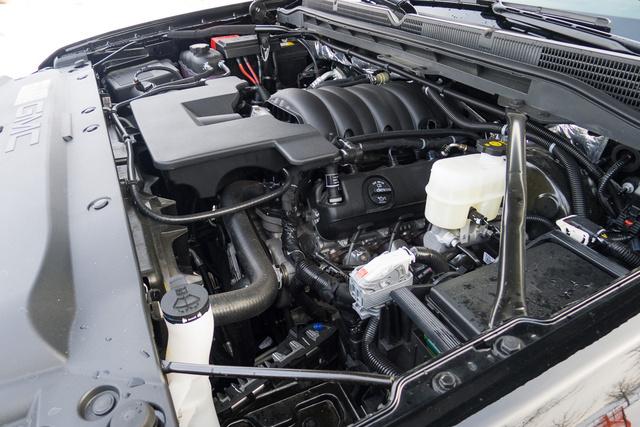2015 Gmc Sierra 1500 Engine 5.3 L V8 Specs

The 2015 GMC Sierra 1500's 5.3L V8, internally known as the EcoTec3 L83, represents a significant step in General Motors' engine technology. This article will delve into the technical specifications, engineering choices, real-world performance, competitive landscape, reliability aspects, and maintenance considerations of this popular powerplant.
Technical Specifications and Engineering Choices
The L83 engine boasts a displacement of 5.3 liters (325 cubic inches) and features an aluminum block and cylinder heads, contributing to weight reduction. It's a 90-degree V8 design with a bore and stroke of 96.01 mm (3.78 in) and 92 mm (3.62 in) respectively. The compression ratio is a relatively high 11.0:1, indicative of its focus on efficiency. A key feature is its direct injection system, which precisely meters fuel directly into the combustion chamber, allowing for optimized combustion and reduced emissions. The engine also utilizes Active Fuel Management (AFM), also known as cylinder deactivation, enabling it to run on only four cylinders under light load conditions, further enhancing fuel economy. Valve timing is handled by a variable valve timing (VVT) system, optimizing valve opening and closing based on engine speed and load. These technologies combined provide a peak output of 355 horsepower at 5600 rpm and 383 lb-ft of torque at 4100 rpm.
GM's engineering choices for the L83 centered around balancing power, fuel efficiency, and durability. The aluminum block reduces weight compared to a cast-iron block, improving overall vehicle dynamics and fuel economy. Direct injection contributes to both power and efficiency by allowing for higher compression ratios and more precise fuel control. AFM's inclusion reflects the growing demand for improved fuel economy in trucks, even at the expense of a slightly more complex valvetrain.
Real-World Performance
In the 2015 GMC Sierra 1500, the 5.3L V8 delivers a satisfying blend of power and usability. The 383 lb-ft of torque provides ample pulling power for towing and hauling, while the 355 horsepower ensures confident acceleration and highway cruising. Real-world fuel economy typically hovers around 16-18 mpg in the city and 22-24 mpg on the highway, depending on driving style and conditions. Independent tests have demonstrated 0-60 mph times in the low 7-second range, which is respectable for a full-size pickup.
Comparison with Alternatives
Competitors to the L83 in 2015 included Ford's 5.0L Coyote V8 and Ram's 5.7L Hemi V8. The Ford Coyote offered similar horsepower but slightly less torque at lower RPM, potentially making the L83 more suitable for towing in some situations. The Ram Hemi provided slightly more horsepower and torque, but often at the cost of fuel economy. While the Hemi offered a more visceral experience, the L83's AFM technology provided a real-world fuel economy advantage in many driving scenarios. Compared to Ford's EcoBoost V6 engines (particularly the 3.5L), the L83 provided comparable torque but generally lacked the low-end grunt of the turbocharged V6, though V8 reliability was often viewed as superior.
Pros and Cons
Pros:
- Good balance of power and fuel economy.
- Proven reliability track record.
- Direct injection for enhanced efficiency and performance.
- Active Fuel Management (AFM) for improved fuel economy.
- Strong towing capability.
Cons:
- Active Fuel Management (AFM) can sometimes exhibit valve lifter issues (discussed further below).
- Direct injection requires periodic intake valve cleaning due to carbon buildup.
- Not as powerful as some competing V8s.
- Fuel economy still lags behind some EcoBoost V6 alternatives.
Reliability Aspects and Maintenance Tips
The L83 engine is generally considered reliable, but it's not without its potential issues. The most commonly reported problem is related to the Active Fuel Management (AFM) system, specifically lifter failure. This can occur due to the complex lifter design used in the cylinders that deactivate. Symptoms include a ticking or knocking noise, particularly at idle or low speeds. Addressing this issue often requires replacing the affected lifters, or even disabling the AFM system entirely.
Another potential concern is carbon buildup on the intake valves, a common issue with direct-injection engines. Because fuel is injected directly into the combustion chamber, it doesn't wash over the intake valves, leading to carbon accumulation. This can reduce engine performance and fuel economy over time. Regular intake valve cleaning, either through chemical treatments or manual cleaning, is recommended.
Preventative maintenance is crucial for maximizing the longevity of the L83. Regular oil changes with the correct viscosity synthetic oil are essential. Following GM's recommended maintenance schedule for spark plugs, air filters, and other components is also important. Additionally, monitoring for any unusual noises or vibrations can help catch potential problems early.
Future Trends
The automotive industry is rapidly evolving, with electrification and alternative fuels becoming increasingly prevalent. While the L83 is a solid engine in its own right, future iterations of GM trucks will likely incorporate hybrid or electric powertrains to meet stricter emissions regulations and consumer demand for improved fuel efficiency. We may see smaller displacement engines paired with turbocharging and electric assist to achieve similar or better performance while significantly reducing emissions. Although the L83 engine may fade out as new technologies emerge, its legacy of balancing power, efficiency, and reliability will continue to influence engine design.
Looking ahead, automotive professionals need to stay informed about the latest advancements in engine technology, including hybrid and electric systems. Expertise in diagnosing and repairing complex hybrid powertrains will be in high demand. As internal combustion engines are gradually phased out, skills in battery maintenance, electric motor repair, and software diagnostics will become increasingly important.
